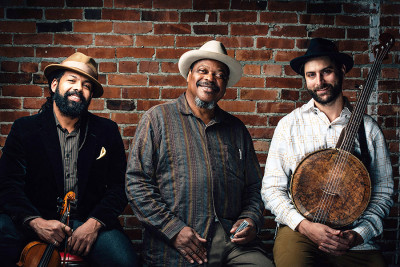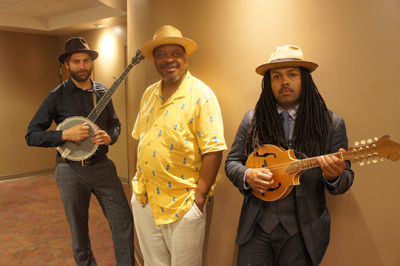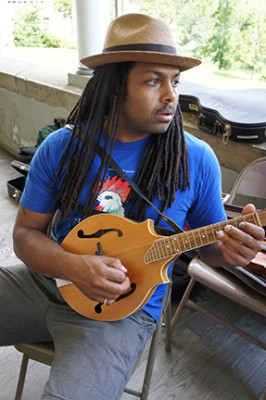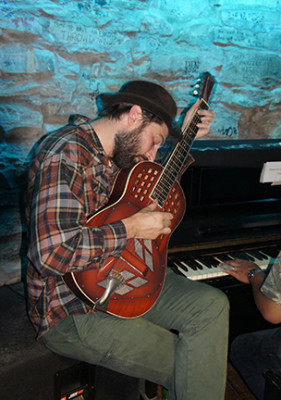As submitted to Living Blues and published in the column Breaking Out LB Issue #248 Vol. 48 #2. Photo Credit : Jim Meyers ©vertizonphoto.com
Publisher’s Note: Ben Hunter is in a regular duo with Seattle musician Joe Seamons, who deserves greater mention here, as this article was specifically about Ben Hunter. Additional work is needed to fill in more information about Joe Seamons.
The Magnanimous Violin of Ben Hunter
By Frank Matheis
There was a time when the violin played a significant role in the early blues. Lonnie Chatmon, Lonnie Johnson, Henry Sims, Howard Armstrong and many others stand as a testament to the beauty and diversity of African American fiddle music. Then the violin faded out of favor for a long time. Happy days are here again! Today we are in the midst of a virtual 21st Century roots & blues fiddle renaissance, with a generous new wave of versatile violinists and multi-instrumentalists: Jerron Paxton, Dom Flemons, Rhiannon Giddens, Cedric Watson and Marcus Moore. Among them is the dreadlocked songster, Ben Hunter, from Seattle in Washington State, who also plays guitar, mandolin and tenor banjo and regularly partners in the duo ‘Ben Hunter & Joe Seamons’. Joe plays guitar and banjo and both sing. Like many of their string-band predecessors of the 1920s and ’30s, they play an amalgam of traditional and old-time music that encompasses a wide range of styles, including blues, jazz, folk, hillbilly and more. An unbridled freedom and genre emancipation is evident in Ben Hunter’s music, yet the deep blues are a cornerstone of his style.
LB caught up with the songster Ben Hunter just as he was embarking on a European tour with Joe Seamons, joined by harmonica ace Phil Wiggins, only a few days before the trio released their new album A Black & Tan Ball. At the time of this writing they are touring Belgium, the Netherlands, Germany and France, the duo’s first European tour, but by no means the first travel experience for Hunter.Ben Hunter’s transient life experience is as adventurous and unconventional as his music: “I was born in Lesotho, Africa. I was there for about a year and then we moved to Zimbabwe, when I was seven. We were there until I was nine and a half, and then came back to Phoenix, Arizona. We lived in Washington State for a couple of years and then Flagstaff, Arizona for a few years and then settled in Phoenix for most of my life. I’ve never known my dad. It was just my mom and I. She believed in traveling. So that’s where our money went. She has her master’s in public health and she was teaching nursing at the university in Harare, Zimbabwe. We traveled through Africa a bit. Later, I went to Walla Walla, Washington, for college and then I moved to Seattle in 2007.”

Equally unique as his early life is his musical education, as a young African American classically trained violinist who found his way to jazz, deep roots and blues fiddling. His individualistic musical path and inspiration are atypical: “I studied music at Whitman, a small college in Eastern Washington. There were two violinists I came upon who have influenced me the most: Stuff Smith and Eddie South (*both African American hot jazz violinists). I read about Eddie South and related to him because of his background as an African American classical violinist who, like me, made the transition over to jazz and blues styles. One of the songs he did was Paganini’s 24th Caprice. Paganini – that was a cold cat. He was kind of the devil of the violin in his day. His music was dark and weird and highly sophisticated. When Eddie South played it, he added this swing to it, which was just crazy. So that had a really profound influence on me…”

“Stuff Smith, he was just too cool because he was so whimsical. His phrasings and technical dexterity was insane… I think a lot of string-band music and blues violin, old-time – any of that country-style violin, is not the most technically difficult violin playing. But Stuff had an accuracy and a style. He really brought something cool to it. Of course Stephane Grappelli influenced me a lot in jazz. Then, I started listening to string band music – like Clifford Hayes That helped me understand how violinists play the blues in a different way. Eddie South and Stuff Smith, they were coming at it from a fierceness, an intensity with cool, crazy, fast riffs. Blues violin in jug band and string band music has a lot more of the subtlety and the nuance. When listening to Lonnie Johnson play the violin there’s a certain style of phrasing that predates jazz. It wasn’t about fast riffs. It was about implementing the sloops and slides and dips and tremolos that come from having a bow as opposed to a pick.”
“I play in a duo with Joe Seamons. We try to listen to the most obscure stuff we can find and try to revive it. We met about five or six years ago and we were naturally attracted to the idea of playing blues and jazz, string band, jug band music, ragtime and waltzes, mazurkas – all different stuff. We went to the Port Townsend Acoustic Blues Festival one year and connected. He plays guitar, banjo and harmonica and sings. Joe is from Lanier, Oregon and lives just northwest of Portland. We just made an album with Phil Wiggins on harmonica, which was an incredible experience. It’s called A Black and Tan Ball. I’m the general manager and founder of a new business in Seattle, called the Black and Tan Hall, and we recorded the album in this building that was built in 1921, originally as a cinema. That’s how we named it. This is going to be our third album together as a duo, a follow up to our last record, The North Wind and the Sun, which we are going to release in two parts. So all in all we’ve got three records out as a duo.”

Hunter’s northwest locality is not exactly the first place that comes to mind when contemplating the ideal place for a young, black roots & blues fiddler to emerge, but he shows that geographic boundaries today are as meaningless as hard line musical genre lines: “I live in Seattle. There’s really nobody else playing roots and blues fiddle or playing the music that Joe and I play. The cats here that are playing violin are playing bluegrass or jazz and they’re all white. What Jerron Paxton does over in New York, and a few others like him – makes me hopeful. The musicologist part of me is a little disconcerted that there aren’t a lot more people getting behind this, because the 1920s and ‘30s stuff was the real deal. Everybody was into this. There’s a lot of this music in New Orleans and the people who come through the Jalopy Theater in Brooklyn. I wish there were more young people doing this. That’s part of the reason why Joe and I teach in schools and try to take this music to other places, because when we do teach kids, they love it. They soak it up. They love it. If you can make it something whimsical, like what Stuff did, and when there aren’t as many rules, then people are really drawn to it.”
Hunter and Seamons recognize the importance string band ensemble music had in the early days: “The cool thing about the old music is that people shared it. They played together. Today music is so much of this individualized thing. I think the blues music that people think about and know about are single people playing guitar and singing the blues, moaning and groaning. I don’t think a lot of people really get the fact that this was social music too and that it was music that transcended the sorrow. It was about singing to feel better.”
Good things are forthcoming from the duo, and each partner individually. “We are working on a documentary film that we did a lot of the shooting for last year. That film is going to explore the status of blues and folk music now – drawn on the question of where it is, where it’s going, who’s doing it, who’s playing it, how it’s being passed down, how it’s being received. Got a bunch of interviews from people along the Mississippi that we interviewed.”
Joe Seamons just issued an album Roll Columbia which aims To Complete Woody Guthrie’s Northwest Legacy by bringing together all of the American folk legend’s Columbia River songs on one album for the first time.

“We also work together on workshop and concert series program called Rhapsody. We host concerts once a month and we teach in schools and take our program around the country. We just recently came from a weeklong workshop in the Quad Cities in Davenport. We teach every week, twice a week, at a middle school in a class called Songsters. We try to cross musical boundary lines, like trying to embed our program in partnerships with Wintergrass Bluegrass Festival, the Centrum Acoustic Blues festival, and Seattle Folklife – attempting to create a more dynamic program of teaching blues and folk music to young people in the Northwest. Hopefully, that will spread also.”
Ben Hunter and his partner Joe Seamons are at once preservationists and, for the roots blues, unanticipated musical revivalists. We need more youngbloods like these!
[Publisher’s After-Note: Since getting to know ben Hunter, it was clear that one of his powerful attributes as a musician is his strong tenor and overall singing capability.]

